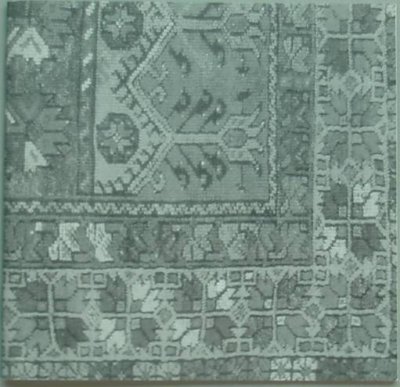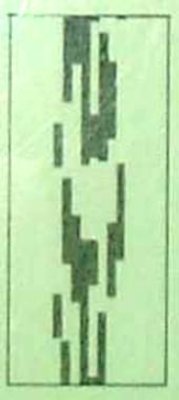A Guided Tour Of East Mohawk With Two Mini-Dramas, A Consideration Of The War Of 1812, And An Unexpected Bunch Of References To Islamic Textiles
By Mark Fenton
Published October 22, 2007
Continued from Part 1
249

This one is almost deserving of an essay in itself. The small verticals at the top counterbalancing, but not mimicking, the large horizontals along the right.
The curves of the masonry which support the almost laughably minuscule "compartments" above remind one inevitably of Jasper Johns -

Target with Plaster Casts 1955, Encaustic and collage on canvas with objects 129.5 x 111.8 cm (51 x 44 in) Collection Mr. and Mrs. Leo Castelli
- though the Mohawk apartment has the good taste to eschew the specificity of body parts in its upper compartments. I prefer to create my own fragmentations of the body, or more elaborate micro-dramas behind each window (a nativity scene; an anthropomorphic domestic interlude for children enacted by rabbits and hamsters; a display of Victorian pharmaceutical apparatus; are only a few three-dimensional environments I imagine, though I'm probably influenced here by the intimate sculpture collage of Joseph Cornell's boxes).

Untitled (Soap Bubble Set), 1936 (140 Kb); Construction, 15 3/4 x 14 1/4 x 5 7/16 in; Wadsworth Atheneum, Hartford, CT
I like it when the windows into people's private lives are opaque. I can write my own stories then.
I also like how the curves of masonry counterpoint the tree which lists inward like a drunk compensating for a landscape that shifts beneath his feet.
The fire hydrant, arms spread with authority, speaks of solidity, order, safety. It urges us to keep back from the unsteady events behind it. And there is the further ambiguity of Robert A. _________? What are we to make of the dropped surname?
Is it Robert A. Heinlein, "hard-science"-science-fiction writer from in the 1950s -

Image Credit: Wikipedia
- or Robert A. Milliken, Nobel prize winner for physics for work on determining the charge of electrons?

This pairing is not some thematic whim on my part; the information is purely mathematical. They were the first two results I got when I typed "Robert A." into Google.
The results speak to me of the optimism of the mid-American century. A brave new world more than half-hopeful about the god of science and technology. The age of the building is appropriate. This façade is the aesthetic and philosophical powerhouse of the Hammer-walk-up.
251

Sure, you're thinking I'm going to make yet another comparison with minimal art. But 251 speaks to me about musical composition: more specifically mid-20th century graphic notation.
With graphic notation composers allowed a certain latitude for performers to make independent decisions about outcomes, and created visual representations for only those element they wanted to control: limits for performers to work with in. Usually a key to the notation was included with the score.
I was all prepared to use the cover photo of a Morton Feldman CD -

- rather cryptically entitled Morton Feldman, ed. RZ 1010 as an example of a spare and baffling graphic notation. In the liner-notes there was no indication of what piece it notated or how it should be read, and I finally came to the conclusion that it was NOT a musical score, but rather an abstracted image of the composer himself, in profile.
 Image Credit: University of Buffalo
Image Credit: University of Buffalo
I'm wildly interested in Feldman, not simply for his spare, gorgeous music but for his interest in Turkish carpets as a visual model for the patterns of his work and which he bought and sold because writing six hour long string quartets (the Mode recording of which is adorned with an example of such a carpet) -

- doesn't necessarily pay for a New York apartment.
So some genuine examples of graphic notation are this one by Cornelius Cardew -

- which appears to be chamber music on helium; or this fragment for Part 2 of Brian Eno's Music for Airports -

- which bears a striking formal resemblance to the Yurdan carpet -

- mentioned earlier in this article.
So here's my idea. I use 251 Mohawk as a ready-made, graphic score. I would have six units of "musical events" indicated by windows. I would not impose an "order" in which to play them.
Instead, the musicians would decide which to play in what order before beginning, or if that's too close to the fascism of the European symphony orchestra, they would choose the order independently of one another. (This follows the pattern of Stockhausen's Klavierstuck no. 11, although in that piece a single performer jumps carelessly from segment to segment of composition, whereas here, depending on the number of performers, permutations become almost incalculable.)
I'm thinking the ideal number of performers would be six, which equals the number of windows and has a nice classicism to it, being half the number of tones in Western scales. It's also probably as many musicians as you can set up on the opposite sidewalk without really messing up people who are trying to run to the bus.)
I would let the horizontal of the window equal duration and the vertical equal dynamic. White = absolute silence, black (that bottom left is going to be intense! which is another good reason for not having all musicians perform the same unit at the same time.)
What I like about this is that the dynamics of the composition will change from time to time as the residents adjust their shades, and it will get very quiet if they all pull them down to get some sleep which is a nice side benefit because after all this is people's lives, it's not JUST my manuscript paper.
The three little trees resemble the notation of drum patterns I've seen in some graphic notations. This rhythm obviously fits outside the windows and I haven't exactly worked out the drum interaction, but give me time.
251 is a metronome marking of some sort. Maybe 251 beats per window and as all the windows divide in half I'd probably use 125 for each half section and the white bar would be a beat of silence before a radical new volume.
As for what pitch each instrument plays, best that each musician selects any five power lines above the building--clef of their own choosing--and allow the edge of the cloud line to supply the melody he or she plays.
I realize this may sound a bit random, but in a band that can really jam together it could be exciting and I think it's time the arts came to Mohawk Road in a big way and if anyone from an arts council is reading this and has a clue what I'm talking about and wants to send me some grant money to get it off the ground, just hit the E-mail at the bottom of this essay and I'll supply my mailing info for the cheque.
253

I've looked long and hard at this one and find it the most challenging of the bunch. Obviously those horizontal bricks cropped up in residential design sometime after the rock slabs in Frank Lloyd Wright's prairie style -

- and the low pitch of the roof and building materials remind me of Wright's Japanese style in general.

I like the few geometric elements of 253. The façade is a perfect square with a few simple quadrilaterals and the perfect 45 degree angle of the fire escape(?!) is thrust boldly downward in a bend dexter to offset any drabness. What's most puzzling though is the nuclear-proof steel doors of the entrance, redolent of those ground level exterior doors in Manhattan which often open into an equally apocalyptic hall and elevator ride and then, astonishingly, open into a lavish apartment worthy of Architectural Digest.
Here though it's hard to know what the heavy doors actually protect. It strikes me that if you wanted in you'd simply trot up the three steps of the fire escape and smash the glass on the first floor. I'd recommend bars there if they want to secure the place as badly as they seem to.
I have no sense of this place as an apartment. I sense it being all open concept inside, renovated for some rather exclusive and ascetic community of glass blowers, or Falun Gong practitioners. But everyone reads a building differently.
257 and 261


Something feels a little bit unfinished about these buildings. They achieve neither the stark minimalism of 245 and 251, nor the Byzantine invention of 241 and 249.
They are somewhere in the middle: a bit bland at the moment, but with potential for a presence that suggests fortitude and power. I see them as a set something the way 233 and 237 are. Might I suggest returning here to my colonial, or should I say "martial," theme.
Throughout the Burlington/Hamilton/Stoney Creek area there are lots of memorials and historical interest plaques for "War of 1812" locales.
Now as soon as anyone mentions the war people tend to immediately think of Brock dying on Queenston Heights and forget all about the Atlantic Theatre. I would recommend naming these buildings Phoebe and Shannon, after the HMS Phoebe which captured the USS Essex and the HMS Shannon which captured the USS Chesapeake off of Boston Harbour.
I'd recommend some period font with maybe ships rigging in metal and one of those allegorical mermaid-like figures you used to see on ships prows. Something classy like that.
I'm not suggesting the War of 1812 theme out of some redneck nationalism. When I am in the United States I am NOT one of those Canadians who gloats about our performance in this conflict, to locals, in taverns.
Canadian: I can see from your uniforms you guys are in the Marines.
1st American: Uh...we're in the Air Force.
Canadian: Right. Right. Anyway I hope you don't mind a Canadian sitting up at the bar next with you. Ha Ha Ha.
1st American: [confused] Um...course not. Welcome to Flint.
Canadian: I mean the fact that, engagement for engagement, us Nucks SERIOUSLY kicked your ass.
[1st American and 2nd American looking at each other like they're trying to place what he's talking about.]
Canadian: But you probably know how it really happened. You guys LOOK like you have grade 12.
2nd American: Well nice to have met you. [1st and 2nd American taking their beers and moving away from the bar to a table.]
Canadian [following them despite four seriously cold shoulders turned his way]: I mean, you wouldn't believe the stuff you hear. You know all the stuff about the "war that both sides won." But Hey! There's still Americans out there who tell you Vietnam was a tie-Hey- Woah-WOAH WOAH!! reLAX guys, there's no need to be like that - I'm just making conversation!
Really, that's not the attitude I'm promoting at all. I just think it's a way of remembering our history and making Mohawk even more of an urban geography attraction than it already is.
265

At first I was intrigued by what seemed like letters to the left of the front entrance. Perhaps some fanciful name or instructions to visitors.
On going closer it turned out to be foliage -

- against a white screen. Giving the approach the simple elegance of Japanese brush painting.

Bamboo (25.8*48.3 cm, by Xia Chang, Ming Dynasty)
269

Here we reach the end of the block. The corner of Seven Oaks. (As you can see, Mohawk 229-269 is a lot to take in at one go and I'd suggest you stretch it over a few days. There are hotels within walking distance.) 269 is a pretty well groomed and landscaped Hammer-walk-up, and you'll note the birch tree to the right leaning away in a kind of awe, so as not to obscure its aspect.
I am a novice when it comes to design, but I had an idea and I'm going share it with you even though you may all laugh, because how the hell am I going to get anywhere if I don't take risks and put my ideas out there.
As you've guessed, Islamic carpets were on my mind as I was photographing Mohawk East. The marriage of mathematics and aesthetics that makes these textiles monuments of world art. I don't pretend to operate in that category but you have to start somewhere.
I found myself focusing on the second floor balcony with its bisected horizontals further bisected by a lattice-like border (maybe not lattice-like...like... maybe it's ACTUAL lattice) running around and through.

I decided to cut in really close and work out a pattern for a rug.





What would be great is that you'd approach the apartment and only register the second balcony subconsciously, and then you'd go in and see this rug I've designed on the floor and go "Hey? Where have I seen THAT pattern before? It really WORKS, although I can't quite say why."
I don't really know anything about the actual process of knotting the bits of fabric (I know people speak of rug-"hooking" so I guess there's a hook-like tool involved) and if anyone wants to use this pattern, go right ahead.
You don't even need to email me for permission, although if you're really nervous about copyright infringement you might want to contact the owner of 269 Mohawk.
By JH (anonymous) | Posted October 23, 2007 at 00:05:24
This is some seriously poststructuralist shit...
thanks Mark.
Another note: although I completely bow to your somewhat ironic use of what first appears to be a bland postindustrial working class dwellings, I was wondering if you could work your tea-leaf interpretive design magic in analysing the designs on a AustroHungarian empire Bosnian rug that I acquired in a shop in old town Sarajevo. I wonder if little conquering AustroHungarians would appear, should the geometric tiling be blown up digitally....you know, sort of like playing Beatles records backwards to unveil the secrets of the universe...
By Mark Fenton (anonymous) | Posted October 24, 2007 at 19:49:44
Dude,
Thanks for the interest, but you're way up on me if you're already dealing in Sarajevo rugs...
In terms of finding images in carpets, the story to read is Henry James' 1896 tale "The Figure in the Carpet" in which the narrator becomes obsessed with the alleged figure in a lavish rug and even considers marrying the heiress who lives in the house in which it lies as she claims she'll explicate it's form only to her husband. After I posted this thing it occurred to me that I might have done something with that, but in retrospect it might have made the essay even more overwrought than I fear it already is. I often feel I have Henry James breathing down my back as I write, so there's probably an anxiety of influence there.
On rainy days I still whip the belt off my turntable and listen backwards to Paul is Dead messages on my old Beatles vinyl and it's still kind of chilling and special for me. I've never got around to doing that thing where you sync Dark Side of the Moon with The Wizard of Oz, but I want to.
Mark
By Rosalind (registered) | Posted October 26, 2007 at 12:51:54
That was an awesome article -thanks. If you ever venture farther west on Mohawk, you can review the Frank Batty building at Upper James, which has the word "smile" written on the side of it!
You must be logged in to comment.
There are no upcoming events right now.
Why not post one?